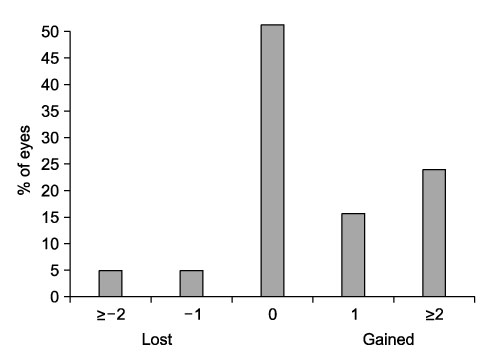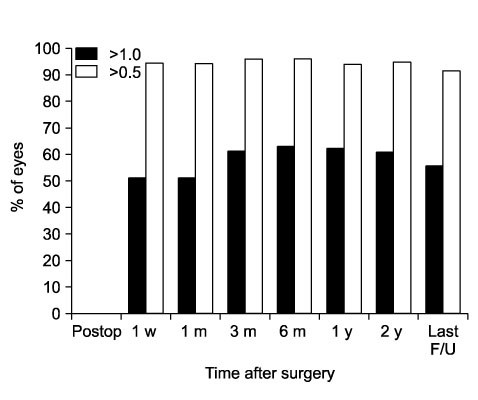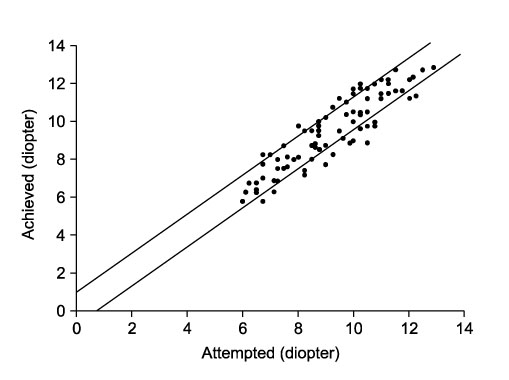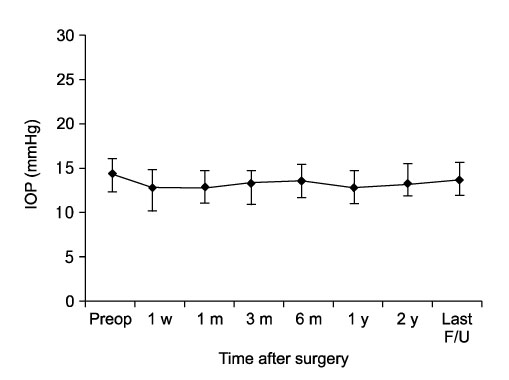Chonnam Med J.
2008 Aug;44(2):93-98. 10.4068/cmj.2008.44.2.93.
Long-term Outcomes and Side Effects after Implantation of Phakic Posterior Chamber Intraocular Lenses
- Affiliations
-
- 1Department of Ophthalmology, Chonnam National University and Hospital, Gwangju, Korea. kcyoon@chonnam.ac.kr
- 2Gwangju Eye Clinic, Gwangju, Korea.
- 3Department of Ophthalmology, Seonam University and Hospital, Gwangju, Korea.
- 4Chonnam National University Research Institute of Medical Sciences, Gwangju, Korea.
- KMID: 2045756
- DOI: http://doi.org/10.4068/cmj.2008.44.2.93
Abstract
- This study was performed to evaluate the long-term results and complications after phakic posterior chamber lens implantation to treat high myopia. Ninety-three eyes of 52 patients with high myopia underwent implantation of implantable contact lenses (ICL V4, Staar Surgical Inc.) and were followed for at least 2 years. Uncorrected visual acuity (UCVA), best corrected visual acuity (BCVA), refraction, intraocular pressure (IOP), corneal endothelial cell count and postoperative side effects were analyzed. At the last follow-up, UCVA was 20/40 or better in 83 eyes (89.3%). Forty-six eyes (49.5%) were predicted accurately to within +/-0.5D, and 68 eyes (73.1%) to within +/-1.0D of predicted refraction. Pigment dispersion was detected in 5 eyes (5.4%) and glaucoma in 3 eyes (3.2%). ICL was removed in 2 eyes (2.2%) due to glare without significant loss of BCVA. No lens opacification or ICL decentration was noted. The results support the long-term safety and efficacy of ICL implantation.
MeSH Terms
Figure
Reference
-
1. Han SY, Lee KH. Long term effect of ICL implantation to treat high myopia. J Korean Ophthalmol Soc. 2007. 48:465–472.2. Chang DH, Davis EA. Phakic intraocular lenses. Curr Opin Ophthalmol. 2006. 17:99–104.
Article3. Duffey RJ, Leaming D. Trends in refractive surgery in the United States. J Cataract Refract Surg. 2004. 30:1781–1785.
Article4. Donoso R, Castillo P. Correction of high myopia with the PRL phakic intraocular lens. J Cataract Refract Surg. 2006. 32:1296–1300.
Article5. Kim JK, Kim SS, Lee HK, Lee IS, Seong GJ, Kim EK, et al. Laser in situ keratomileusis versus laser-assisted subepithelial keratectomy for the correction of high myopia. J Cataract Refract Surg. 2004. 30:1405–1411.
Article6. Olson RJ, Werner L, Mamalis N, Cionni R. New intraocular lens technology. Am J Ophthalmol. 2005. 140:709–716.
Article7. Saragoussi JJ, Cotinat J, Renard G, Savoldelli M, Abenhaim A, Pouliquen Y. Damage to the corneal endothelium by minus power anterior chamber intraocular lenses. Refract Corneal Surg. 1991. 7:282–285.
Article8. Mimouni F, Colin J, Koffi V, Bonnet P. Damage to the corneal endothelium from anterior chamber intraocular lenses in phakic myopic eyes. Refract Corneal Surg. 1991. 7:277–281.
Article9. Menezo JL, Cisneros AL, Rodriguez-Salvador V. Endothelial study of iris-claw phakic lens: four year follow-up. J Cataract Refract Surg. 1998. 24:1039–1049.
Article10. Uusitalo RJ, Aine E, Sen NH, Laatikainen L. Implantable contact lens for high myopia. J Cataract Refract Surg. 2002. 28:29–36.
Article11. Assetto V, Benedetti S, Pesando P. Collamer intraocular contact lens to correct high myopia. J Cataract Refract Surg. 1996. 22:551–556.
Article12. Sanders DR, Vukich JA, Doney K, Gaston M. U.S.Food and drug administration clinical trial of the implantable contact lens for moderate to high myopia. Ophthalmology. 2003. 110:255–266.
Article13. Jiménez-Alfaro I, Benitez del Castillo JM, García-Feijoó J, Gil de Bernabé JG, Serrano de La Iglesia JM. Safety of posterior chamber phakic intraocular lenses for the correction of high myopia: anterior segment changes after posterior chamber phakic intraocular lens implantation. Ophthalmology. 2001. 108:90–99.
Article14. Gonvers M, Othenin-Girard P, Bornet C, Sickenberg M. Implantable contact lens for moderate to high myopia: short-term follow-up of 2 models. J Cataract Refract Surg. 2001. 27:380–388.15. Arne JL, Lesueur LC. Phakic posterior chamber lenses for high myopia: fuctional and anatomical outcomes. J Cataract Refract Surg. 2000. 26:369–374.
Article16. Rosen E, Gore C. Staar Collamer posterior chamber phakic intraocular lens to correct myopia and hyperopia. J Cataract Refract Surg. 1998. 24:596–606.
Article17. Lee SY, Cheon HJ, Baek TM, Lee KH. Implantable contact lens to correct high myopia (clinical study with 24 months follow-up). J Korean Ophthalmol Soc. 2000. 41:1515–1522.18. Yoon KC, Park YK, Cho CW, Park YG. Effect of implantable contact lens for high myopia. J Korean Ophthalmol Soc. 2004. 45:38–44.19. Chun YS, Lee JH, Lee JM, Jwa WB, Hong SJ, Lee YH, et al. Outcomes after implantable conatact lens for moderate to high myopia. J Korean Ophthalmol Soc. 2004. 45:480–489.20. Heitzmann J, Binder PS, Kassar BS, Nordan LT. The correction of high myopia using eximer laser. Arch Ophthalmol. 1993. 111:1627–1634.21. Menezo JL, Peris-Martinez C, Cisneros A, Martinez-Costa R. Posterior chamber phakic intraocular lenses to correct high myopia: a comparative study between Staar and Adatomed models. J Refract Surg. 2001. 17:32–42.
Article22. Pesando PM, Ghiringhello MP, Tagliavacche P. Posterior chamber collamer phakic intraocular lens for myopia and hyperopia. J Refract Surg. 1999. 15:415–423.23. Lackner B, Pieh S, Schmidinger G, Simader C, Franz C, Dejaco-Ruhswurm I, et al. Long-term results of implantation of phakic posterior chamber intraocular lenses. J Cataract Refract Surg. 2004. 30:2269–2276.
Article24. Lackner B, Pieh S, Schmidinger G, Hanselmayer G, Dejaco-Ruhswurm I, Funovics MA, et al. Outcome after treatment of ametropia with implantable contact lenses. Ophthalmology. 2003. 110:2153–2161.
Article25. Trindade F, Pereira F. Cataract formation after posterior chamber phakic intraocular lens implantation. J Cataract Refract Surg. 1998. 24:1661–1663.
Article26. Fink AM, Gore C, Rosen E. Cataract development after implantation of the Staar Collamer posterior chamber phakic lens. J Cataract Refract Surg. 1999. 25:278–282.
Article27. Sanchez-Galeana CA, Smith RJ, Sanders DR, Rodriguez FX, Litwak S, Montes M, et al. Lens opacities after posterior chamber phakic intraocular lens implantation. Ophthalmology. 2003. 110:781–785.
Article28. Chun YS, Park IK, Lee HI, Lee JH, Kim JC. Iris and trabecular meshwork pigment changes after posterior chamber phakic intraocular lens implantation. J Cataract Refract Surg. 2006. 32:1452–1458.
Article29. Edelhauser HF, Sanders DR, Azar R, Lamielle H. ICL in Treatment of Myopia Study Group. Corneal endothelial assessment after ICL implantation. J Cataract Refract Surg. 2004. 30:576–583.30. Keuch RJ, Bleckmann H. Pupil diameter changes and reaction after posterior chamber phakic intraocular lens implantation. J Cataract Refract Surg. 2002. 28:2170–2172.
Article
- Full Text Links
- Actions
-
Cited
- CITED
-
- Close
- Share
- Similar articles
-
- Anterior Chamber Phakic Intraocular lens in Patients with high Myopia
- Long-term Change in Corneal Endothelium After Iris-fixed Phakic Intraocular Lens Insertion
- Implantation of Posterior Chamber Intraocular Lens by Transscleral Suture Fixation: Long-term Results
- Implantation of Posterior Chamber Lens in the Absenee of Posterior Capsular Support
- Visual Improvement in High Myopic Amblyopic Adult Eyes following Phakic Anterior Chamber Intraocular Lens Implantation






